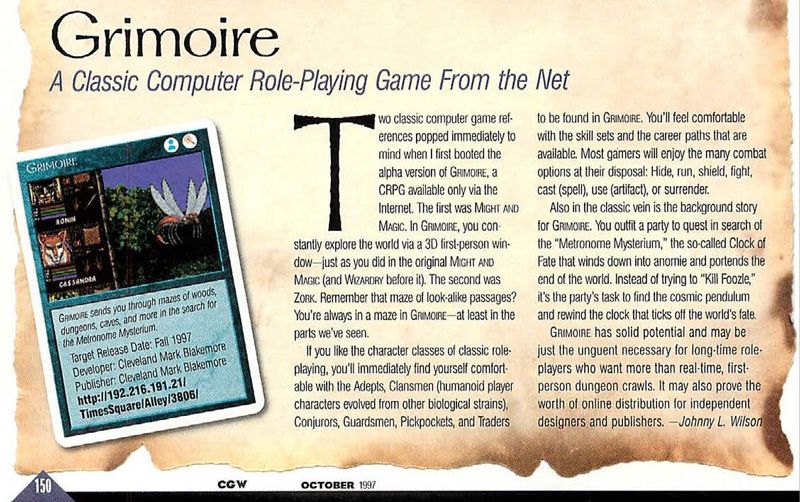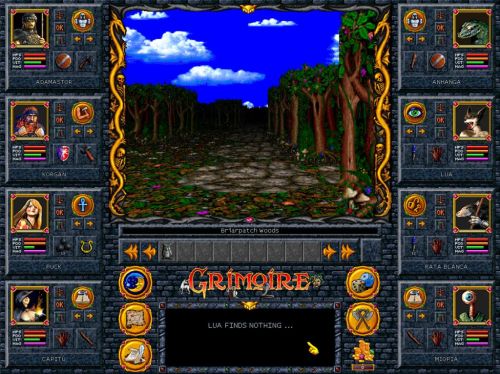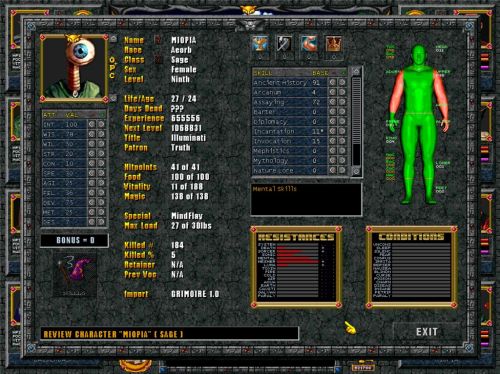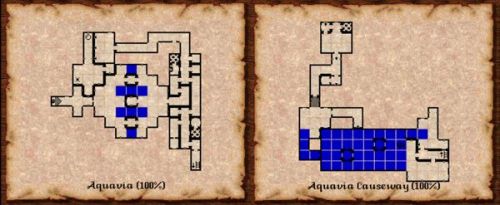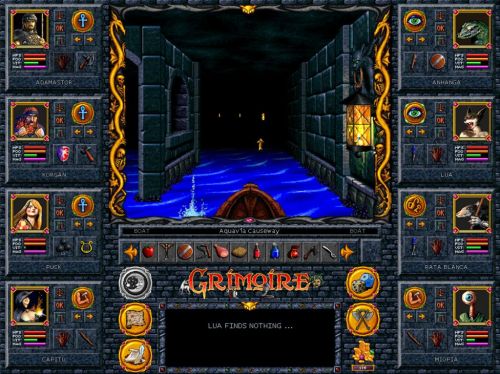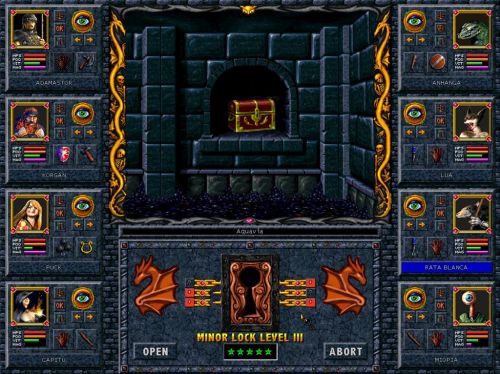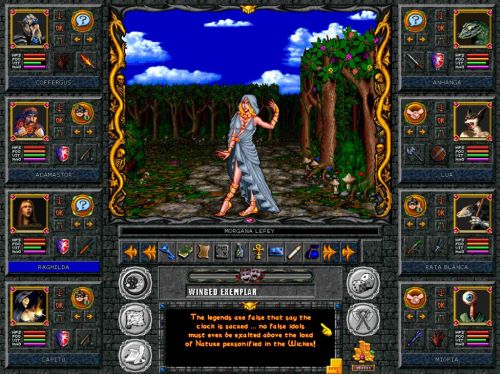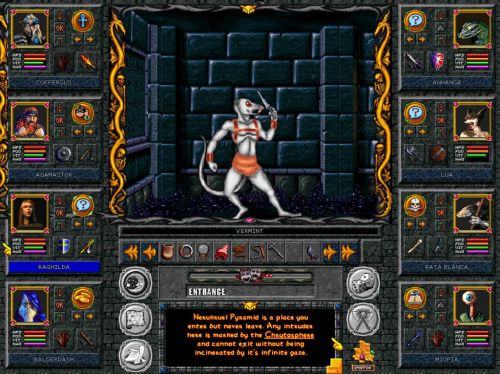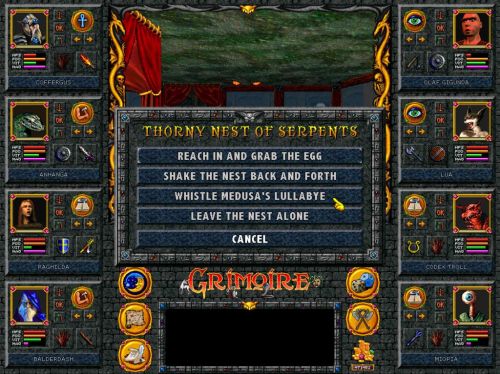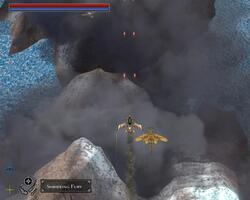RPG Codex Review: Grimoire: Heralds of the Winged Exemplar
RPG Codex Review: Grimoire: Heralds of the Winged Exemplar
Codex Review - posted by Infinitron on Mon 21 August 2017, 00:34:28
Tags: Golden Era Games; Grimoire: Heralds of the Winged Exemplar[Review by felipepepe]
The Grimoire Saga
It's impossible to talk about Grimoire: Heralds of the Winged Exemplar without first mentioning some of its particularities. The game I played this month was once a legendary vaporware, that put Duke Nukem Forever to shame. Its first release date was "Fall 1997", as announced back on the Computer Gaming World magazine:
Its creator, Cleveland Mark Blakemore, is also directly connected to the legendary Wizardry series - in the early 90s he worked on the cancelled sequel to Wizardry VII, Wizardry: Stones of Arnhem.
His work on Grimoire spanned decades - always in a state of "almost finished", always missing release dates. It was constantly discussed on Usenet, accused of using code from Wizardry, disputed trademarks with Grimoire: Manastorm and other wondrous feats. Two Indiegogo campaigns were made, one in 2012 and another one in 2013 - raising over 16,000 dollars in total - and resulting in a demo in early 2013, later followed by a huge Super Demo. The game went to Steam Greenlight earlier this year, was approved, suffered a few more delays and FINALLY got released on 4 Aug, 2017.
Now, after more than twenty torturous years, we can finally play it. So let's dive into it.
Back to 1992
Grimoire is a turn-based, step-based dungeon-crawler and, for all intents and purposes, a spiritual successor to Wizardry VII.
You start by creating a party of eight characters - selecting one of 14 races (Human, Drow, Drake, Feyfolk, Wolfin, Naga, Vamphyr, etc), rolling dice and seeing which of the 15 classes you quality for. Then re-rolling dozens of times until you get enough bonus points for the class you want. It's a daunting process for newcomers and even for veterans at the moment, as the game currently has no manual or info tooltips.
Not the best start, and that's why I can't give a detailed breakdown of the character system. It's based on 11 stats and about 50 skills - some of which can only be learned at certain locations & with certain NPCs. I honestly have no idea what some of these do, and had to roll my team blindly, guessing what stats, spells & skills each class uses.
Once you start the game, you'll be struck either by nostalgia or revulsion depending on your age. Grimoire is truly a game from the 90s, and its user interface is proof of that. It's composed of a myriad of tiny icons, has no hotkeys or even support for mouse wheel scroll. It's not terrible, but it's obviously dated.
To cast a spell with your caster, for example, you have to scroll through the icons next to his portrait until you get to the spellbook icon. Then you choose a spell and which power level to cast - represented here by a series of dice, just like Wizardry VII. This made sense to me, but for someone younger it probably won't. Still, there are some cool things Wizardry didn't offer, like an auto-map which allows you to take notes and "auto-walk" to certain locations, but the tiny shared inventory in the middle of the screen is a pain to use - especially later on, when having a lot of items, carrying several containers and trying to find something.
Grimoire has five starting areas you can choose in the Configurations menu - some harder but offering better starting loot, others offering items that can be used to open optional areas later on. The game's default starting location, The Shrine, also draws directly from Wizardry VII with an open field with a short tutorial dungeon nearby - followed by a town and the first "real" dungeon - Aquavia.
I'd like to take some time here, because Aquavia is a great showcase of why Grimoire works. The dungeon only has two areas, which are relatively small but packed with content.
There is a distinct entrance with water and a simple puzzle based on a hidden switch, some wandering around with a challenging hand-placed encounter and some lore tidbits to set the stage, a door locked with a riddle, an underground river you navigate on a boat to solve another puzzle, leading into a cerimonial chamber where the boss awaits.
It's all very atmospheric and concise. There's even a fairly elaborate secret hidden behind an optional boss that helps you with your fight against the real boss at the end. And there's absolutely no hand-holding.
For fans of old-schools RPG, this is porn.
It's the kind of experience that no modern RPG offers - even niche Japanese DRPGs like Etrian Odyssey focus only on the combat and forget the puzzles & atmosphere. I fully recommend that anyone curious about CRPGs and dungeon design plays through this starting area - you can try it in the freely available Super Demo.
Adventures in Hyperborea
Grimoire offers five difficulty settings, from Novice to Super Hero (I played on the middle one, Advanced), and also a very appreciated "random encounter rate" option. You can set it to Onslaught, which means every few steps an enemy will attack you, all the way to down to Never. However, "Never" doesn't mean there won't be combat, as each area has several hand-placed encounter points - usually when you pass through a door or narrow passageway. I started playing on Rare, then turned it down to Never since I was constantly walking around trying to figure out puzzles and didn't want to keep fighting - more on that later.
While exploring you'll come across several puzzles based on finding & using items, uncovering secret switches and fake walls, pulling levers or entering codes into dials. Some also require you to explore an area, learn about its lore and use that to figure out a code or a sequence of actions. Things never get too complex and most can be brute-forced, but their contextualization makes them engaging - even if they start to feel repetitive after a while.
Doors are unlocked by solving riddles (much like those in Betrayal at Krondor), while chests are unlocked by a guessing mini-game similar to Minefield.
I enjoyed the door riddles, but the chest lockpicking doesn't seem to work as intended. Supposedly those green stars in the bottom are my chances to make mistake, which increase with my Lockpicking skill - but often traps would trigger even on my first mistake. There's also the option to force doors, which I only read about after 60 hours of playing the game - again, there's no manual.
Soon after leaving Aquavia you'll come across the game's first settlement, the Village of Crowl. It's a small area, with a handful of NPCs standing in their houses, ready to chat, trade or join you. In truth, Crowl is the only real town in the game, as the other only has a single NPC. This isn't necessarily a problem, but Grimoire has a severe lack of stores - which we'll address soon.
In true old-school fashion, dialog is done via a text prompt, which can be intimidating. Early NPCs will talk to you and throw some keywords you can ask (they're underlined), but some later ones will just stare at you - there's no way to progress unless you know what to type. As an Ultima veteran I tried to ask them about JOB and that worked great but, once again, younger players might feel lost here. Also, some are really picky about keywords - names, for example, must be fully typed: you can't just type Morgana when asking about Morgana Lefey.
A cool feature is that some dungeons have NPCs that will help you if you take them along - explaining some puzzles or unlocking secrets. The downside is that you can't speak with them while they're in your party, which can be frustrating sometimes or lead you to having to dismiss them, backtrack to their spawn location & recruit them again.
One thing to keep in mind is that NPCs can be really overpowered early on. They start with 40-50 points in basically every skill their class offers, while your characters will barely have 10 points in their main weapons. Later on you'll find powerful hidden NPCs (you can even resurrect dead bones) and those feel more like you earned it, but it's still a bizarre balance choice.
Another aspect of the game's olden design logic is the lack of side-quests - at least of modern-style ones. You'll never be asked to kill 5 boars. In fact, rarely anyone will ask anything of you. Things just happen during your exploration. You find an odd item, examine it, use it the way it's implied and uncover a secret area - there's no quest compass or hints unless you uncover them yourself. The quest journal records key information you find so you don't have to take notes, but that's it.
The cracks begin to appear
While all that is great, the more I played the more I felt like there's a bunch of things that aren't working as they should.
Treasure chests always gave them same kind of loot, drawn from a very small loot table. I rolled a Ranger, had a bow, but couldn't get arrows until around 40 hours of playing. I was swimming in cash, but there was nothing to buy, as stores have very limited inventory and never restock. Lock-picking grew increasingly difficult, making unlocking everything with magic or just brute-forcing them much simpler. Combat was fun and challenging, but I started to see that only a few tactics were effective, and most of my large spell library was useless.
I suppose I should also address the graphical side - it doesn't bother me, but some people will care. Grimoire's artwork uses mostly an almost-cute hand-drawn style that looks cool and has a heavily 90s feel. There are only a couple of tilesets, which grows repetitive as the game advances, but the few that exist look distinct enough. However, somewhere along the way compromises were made, leading to several different styles appearing - from digital painting to Japanese-style characters and even some portraits done in bad 3D art.
Still, I kept playing. I was really having a blast, and I'd say the first 15-20 hours of Grimoire were some of the best RPG experiences I ever had. The dungeons were solid, the puzzles had offered those "eureka!" moments and the game does a great job connecting the multiple ongoing story threads in interesting ways.
This first region has several themes going on - a missing girl, a temple to a templar Saint, a dwarven mining expedition that "dug too deep", a nearby Lich locked in his vault, soldiers searching for a lost relic... but, unlike theme park RPGs like Fallout 3, they all tie together. They're interconnected, to solve one is to solve all - which feels great.
Then, at the end of the main quest in that first region, I reached the worst puzzle in the game, one that I'm sure will frustrate many players, so I'll spoil it here entirely - just skip the colored text if you're not interested in the solution.
While exploring a seemingly unimportant cave I found a Cosmic Egg, described as an item used to speak with the Winged Herald (which is an Owl). Cool. The area just before the cave was a mountain with a bird's nest atop it, so I happily took my Cosmic Egg there, excited to see what was going to happen. But nothing happened. Turns out I had to:
Crush the egg on a hydraulic press at a dwarven mining site to get its "Cosmic Yolk",
Find a hidden Poem at the Monk's Catacomb,
Use said Poem as code to get a Jeweled Egg from a weird machine at the Museum of Magic,
Put the Cosmic Yolk inside the Jeweled Egg,
Put the Jeweled egg back into the weird machine to get a tiny Clockwork Owl,
Take the Clockwork Owl back to the mountain and put it on the bird's nest.
Activate it, see it fly into the sky and then sleep to wait for it to return,
FINALLY grab the key he'll bring you.
There's a lot wrong here - there's no clue whatsoever for most of these actions, especially regarding the machine at the Museum of Magic. The machine is called the "Chronoworks of Kroondergraf" - its description says that no one knows what it does, and it's placed alongside other curiosities such as singing flowers. In a game full with Easter Eggs, such as bones of Indiegogo backers in the catacombs and even an RPG Codex troll, I quickly dismissed it as just another joke.
All this could be forgiven if this was just a side-quest or a very special treasure hunt, but this is the main quest! It was a frustrating experience - the worst puzzle in the game, that really sticks out from the rest.
Still, my biggest frustration was yet to come.
The broken combat
By this point I was already upset by how some spells like Charm, Sleep or Paralysis were too powerful and worked on everyone - even bosses - making fights against single creatures very easy to exploit.
When I finally solved the above puzzle and faced the game's first "big boss", things got dirty. It's a demon that attacks several times per turn, deals ridiculous amount of damage, is immune to most weapons, regenerates life each turn AND can summon an army of Lovecraftian horrors. It's such an absurd difficulty spike that I had no chance to beat it fairly.
Earlier other people playing Grimoire had noticed that the Bard class was broken - its attacks were too powerful and always hit - so I had stopped using mine. Here, I got him back & spammed paralysis music. The boss attacked, dealt a lot of damage, my bard paralyzed him and he stayed paralyzed for the rest of the battle - completely harmless.
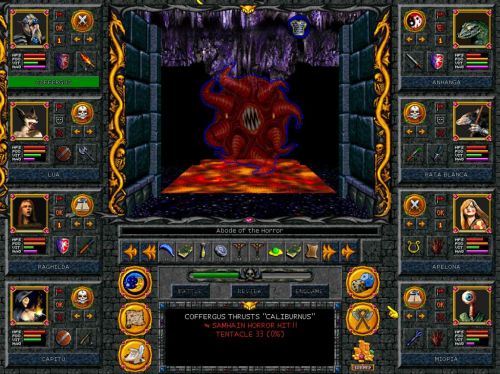
Half of my party is hiding because they were useless here - it was all the Bard & the Magic Sword guy.
That felt cheap, but I dismissed my Bard again and kept playing. Then I started to find monsters that instantly killed 1-2 characters in the first turn, before I could even act. This wasn't due to low HP - the blows were insta-kill. Many also heal themselves each turn. So I stopped saving mana and began to spam my most powerful spells right upfront, ending battles as quickly as possible - you can rest anywhere anyway. And this "arms race" kept going, getting worse and worse...
Later, an extremely fast boss attacked me TWENTY TWO TIMES before anyone in my party could act - oh, and its attacks kill instantly if they hit. Once this Russian roulette marathon ended, I simply used a Hold Monster scroll. The boss was paralyzed and quickly killed. Much tactics, very RPG.
After dozens of hours playing, I finally reached a boss that was immune to most status effects AND didn't slaughter half of my party in one round. Here I experienced a glimpse of glorious combat - slowly fighting enemies, keeping your barriers and HP up, dealing with deaths & debuff and slowly destroying the monster. But it was only a glimpse. In the forth round my Ranger scored a critical hit with his Lethal Strike skill. The boss died instantly, despite all its resistances and still having 80% health.
This wasn't a lucky, one-in-a-million hit, it happened several times. The game's main bad guy died like this in the very first turn - I actually reloaded to see how his fight was like!
By this point I completely gave up on the combat.
I turned the difficulty down to Novice, got my over-powered Bard back and began to cheese every single battle. In response, the game did basically the same. By this point it was all just a quick draw competition - fights rarely went beyond a single round, with either my part or the enemy destroyed by abilities that would kill in one blow.
Of course, every RPG has a few cheesy tactics or overpowered items, spells, skills and builds. With a good guide you can usually become nearly-invincible. But I played Grimoire blindly, without even knowing what most stats do. And there were so many overpowered things - items, skills, spells and even recruitable NPCs - that you basically need a guide on how NOT to cheese: don't use Deep Freeze, Bards, Hold Monster, Lethal Blow, Vorpal Sword, Paralysis, Psychopompic Orb, Time Stop, Crown of Gorgon, etc. But even if you stop cheesing, enemies certainly won't.
More than just the numbers that pop up during combat, the enemies make little sense. Each area has an encounter table from which it draws enemies, and those can vary A LOT - in the same area you might get a large squad of fairies that will kill half your party before you can even act; OR you can get a dumb monk that will die in the first hit. Over 60 hours in I would still get to fight weak enemies from the first areas of the game! It got to the point that sometimes I had to save-scum encounters until they gave me a reasonable enemy.
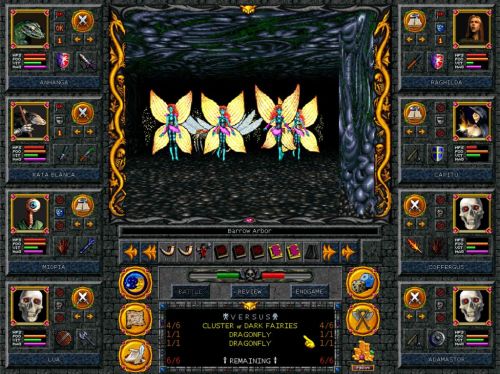
In a single turn they killed three party members, charmed two, blinded two and summoned Dragonflies that kill with one attack.
Yet even beating the most powerful foes the game threw at me felt unfulfilling. Enemies never drop anything except a few keys for chests, and XP rewards are also completely unbalanced. In the same area you might fight weak enemies that give you 4,000xp, while the deadly ones will give like 100xp. By the end-game my characters needed around 200,000xp to reach the next level, but enemies there gave only like 500xp - and the game's final quest gave me only 9,000xp! As a result, I never reached level 10 with any character, and never could try the whole class change feature that supposedly allows you to unlock classes like Pirate, Assassin and Jester.
To make things weirder, Grimoire employs some controversial death mechanics: each time you resurrect a character, his constitution goes down. And some races can only be resurrected by rare spells. In games like Wizardry VII this was already a challenge but, in an unbalanced mess where character death is basically inevitable, this meant ALL my original party members eventually reached the lowest constitution possible. Since they had stopped leveling up due to poor XP, I was effectively growing weaker the more I played.
For a final showcase of how unbalanced this game is, take the Hall of Gorrors in Wizardry VII. That was the game's ultimate challenge, an optional area with super-hard boss battles, some of which would take over 20 minutes to beat with a high level party. Grimoire, of course, has its own "Hall of Gorrors" near the end, with seven optional bosses.
I killed all of them in the first turn.
"Just one more area"
So, with the combat & game balance in this sorry state, why the hell did I keep playing Grimoire?
Well, first I had a prestigious review to write. Second, because the game truly excels at one thing that modern RPGs just don't deliver: the constant call to adventure.
After you finish the first major quest and find the first of the Stone Tablets, the game opens into a massive world (this was where the Super Demo ended). Now you can explore in any direction, searching for the remaining seven Stone Tablets. It's hard to convey just how large this world is. It's easily more than twice the size of Wizardry VII, possibly thrice. While at this point the maps lose that conciseness of the initial areas, they're still reasonably sized, meaning you go through them at a quick pace, constantly experiencing new things. And some of these are quite well presented - not with fancy graphics, but with charming descriptive text, that nails that old-school AD&D-ish vibe.
You enter a new area, a giant pyramid looms in the horizon... as you get close, you cross a field of charred bones and see a humanoid rat desperately running towards you, his eyes begging for help. Before you can do anything, a light flashes atop the pyramid and burns the rat to a crisp. As the smoke dissipates, you see the giant doors of the pyramid, inviting you in. At that point, I'm sold - into the pyramid we go!
Like a RPG version of Civilization's "one more turn" cycle, there's always something just waiting to be discovered. Got into the a flooded city raided by Naga? Now there's a pirate compound for you to infiltrate by disguising yourself! Got past the pirates? Here's a magical sea chariot! And there's a sunken ship! And next to it is the Kraken that sank it! Got past it? Here's a giant ancient tower! And so on.
That's not to say that the design is always good. Grimoire has features like no-magic zones, darkness areas, spinners (tiles that randomly rotate you) and "no rest" areas, but there are all rarely and rather poorly used. Spinners and dark areas are pointless when the auto-map tracks everything and you can just cast "Wizard Eye" to reveal the entire map. There's no maze with disabled auto-map or combat gauntlet that doesn't allow resting. You won't find many traps either - monsters aside, the dungeons are pretty harmless, a big step down from other blobbers of this kind.
Also, while some areas have several themes that tie into each other, others are much simpler or feel like they're too big for their own good - exactly the opposite of what made the first dungeon so fun. The Bahomet Megalith, for example, had large areas where you just mindlessly walk around looking for levers, fighting every 5 steps or so. The worst offenders are two optional mazes with several levels each, but that offer nothing but empty corridors, repetitive encounters and maybe a treasure chest.
Once you finish the path you're in, you'll usually find one of the Stone Tablets - but also a few key items that might be useful somewhere else. Some of these are really cool - I especially enjoyed things like killing the Naga Queen then finding one of her eggs and having various choices in what to do with it. Or disabling a powerful ancient weapon, getting pass a difficult skill check and taking it with me to use in combat.
Then off you go, into the next adventure or trying to find where to use your freshly acquired loot. This also helps to avoid being stuck - if you hit a wall, just go somewhere else.
However, here another big problem appears. During my journey I explored a massive network of 183 maps, which sounds awesome - until you have to backtrack through them. And you'll have to do that often. I never found a teleport spell or equivalent, and the game's quick travel system is nothing but six "Moongates" that connect to each other - which are optional and very difficult to activate. I once saw a puzzle which I knew the solution was somewhere else, and to reach it I had to cross twenty maps one by one. Luckily there's an "auto-walk" system, where you point to a location on the current map and your party goes there, but I still had to do that twenty times.
So yeah, the first 15-20 hours of Grimoire were an excellent RPG - the remaining 60 hours were basically a fun adventure game with broken combat.
Still not done after over 20 years...
Sadly, combat & balance are not the only issues here. Grimoire's release was filled with bugs and crashes, with people reporting several issues and even being unable to start the game. To Cleve's credit, many of these issues were solved in about a week, but had a hefty cost - one of the early patches made previous save games incompatible, forcing a lot of people to restart their game after hours of progress. This frustrated many players, and caused reviewers like Rock Paper Shotgun's Alec Meer to give up on the game.
Yet, even after all this, the game I completed two weeks after launch still had glaring issues.
I still had to deal with several crashes, the game not working in fullscreen, mouse lag, bugs like armor and HP going negative, items that couldn't be picked up, duplicated items, objects that couldn't be interacted with, spells that did nothing and so on. One issue that got me especially mad was when I briefly dismissed my NPC Cleric to make room for another NPC. When I went back to recruit her again, she had "reset" - lost all the levels, XP, skills and spells she had learned over the past 40hs. I ended up reloading a much older save game and losing over an hour of progress.
The never-ending story
It took me 80 hours to finish Grimoire - a far cry from the supposed "600 hours of gameplay". I found four endings, but they were all next to each other in the final area, and offered just an image with a brief text description. The game still felt too long for its own good sometimes, but the end-game is a return to form, with a very "80s CRPG" plot twist.
The truth is that there's a great game behind all the flaws I mentioned. Properly balanced, documented and polished, Grimoire could be a gem that rivals Wizardry VII and its peers - a crown jewel of the blobber / DRPG / Dungeon-crawler genre.
The problem is there's more than just that in the way - its 20 year development time, the Sir-Tech drama, broken promises, countless missed dates and, now, the unfinished release & drama here and on the Steam forums - all this inevitably derails most discussions about the game.
Most developers would get Grimoire up to speed in a few months, but making predictions about Grimoire's development has proven to be a fool's errand. I suggest people treat it as what it still is - a work in progress. Those eager to dive in should know there's many issues and understand they won't get the best experience right now. Everyone else should probably wait for the next chapter in this 20+ year saga.
Or just play the Super Demo - it's free, lasts 15-20 hours and offers some of the best parts of the game.
The Grimoire Saga
It's impossible to talk about Grimoire: Heralds of the Winged Exemplar without first mentioning some of its particularities. The game I played this month was once a legendary vaporware, that put Duke Nukem Forever to shame. Its first release date was "Fall 1997", as announced back on the Computer Gaming World magazine:
Its creator, Cleveland Mark Blakemore, is also directly connected to the legendary Wizardry series - in the early 90s he worked on the cancelled sequel to Wizardry VII, Wizardry: Stones of Arnhem.
His work on Grimoire spanned decades - always in a state of "almost finished", always missing release dates. It was constantly discussed on Usenet, accused of using code from Wizardry, disputed trademarks with Grimoire: Manastorm and other wondrous feats. Two Indiegogo campaigns were made, one in 2012 and another one in 2013 - raising over 16,000 dollars in total - and resulting in a demo in early 2013, later followed by a huge Super Demo. The game went to Steam Greenlight earlier this year, was approved, suffered a few more delays and FINALLY got released on 4 Aug, 2017.
Now, after more than twenty torturous years, we can finally play it. So let's dive into it.
Back to 1992
Grimoire is a turn-based, step-based dungeon-crawler and, for all intents and purposes, a spiritual successor to Wizardry VII.
You start by creating a party of eight characters - selecting one of 14 races (Human, Drow, Drake, Feyfolk, Wolfin, Naga, Vamphyr, etc), rolling dice and seeing which of the 15 classes you quality for. Then re-rolling dozens of times until you get enough bonus points for the class you want. It's a daunting process for newcomers and even for veterans at the moment, as the game currently has no manual or info tooltips.
Not the best start, and that's why I can't give a detailed breakdown of the character system. It's based on 11 stats and about 50 skills - some of which can only be learned at certain locations & with certain NPCs. I honestly have no idea what some of these do, and had to roll my team blindly, guessing what stats, spells & skills each class uses.
Once you start the game, you'll be struck either by nostalgia or revulsion depending on your age. Grimoire is truly a game from the 90s, and its user interface is proof of that. It's composed of a myriad of tiny icons, has no hotkeys or even support for mouse wheel scroll. It's not terrible, but it's obviously dated.
To cast a spell with your caster, for example, you have to scroll through the icons next to his portrait until you get to the spellbook icon. Then you choose a spell and which power level to cast - represented here by a series of dice, just like Wizardry VII. This made sense to me, but for someone younger it probably won't. Still, there are some cool things Wizardry didn't offer, like an auto-map which allows you to take notes and "auto-walk" to certain locations, but the tiny shared inventory in the middle of the screen is a pain to use - especially later on, when having a lot of items, carrying several containers and trying to find something.
Grimoire has five starting areas you can choose in the Configurations menu - some harder but offering better starting loot, others offering items that can be used to open optional areas later on. The game's default starting location, The Shrine, also draws directly from Wizardry VII with an open field with a short tutorial dungeon nearby - followed by a town and the first "real" dungeon - Aquavia.
I'd like to take some time here, because Aquavia is a great showcase of why Grimoire works. The dungeon only has two areas, which are relatively small but packed with content.
There is a distinct entrance with water and a simple puzzle based on a hidden switch, some wandering around with a challenging hand-placed encounter and some lore tidbits to set the stage, a door locked with a riddle, an underground river you navigate on a boat to solve another puzzle, leading into a cerimonial chamber where the boss awaits.
It's all very atmospheric and concise. There's even a fairly elaborate secret hidden behind an optional boss that helps you with your fight against the real boss at the end. And there's absolutely no hand-holding.
For fans of old-schools RPG, this is porn.
It's the kind of experience that no modern RPG offers - even niche Japanese DRPGs like Etrian Odyssey focus only on the combat and forget the puzzles & atmosphere. I fully recommend that anyone curious about CRPGs and dungeon design plays through this starting area - you can try it in the freely available Super Demo.
Adventures in Hyperborea
Grimoire offers five difficulty settings, from Novice to Super Hero (I played on the middle one, Advanced), and also a very appreciated "random encounter rate" option. You can set it to Onslaught, which means every few steps an enemy will attack you, all the way to down to Never. However, "Never" doesn't mean there won't be combat, as each area has several hand-placed encounter points - usually when you pass through a door or narrow passageway. I started playing on Rare, then turned it down to Never since I was constantly walking around trying to figure out puzzles and didn't want to keep fighting - more on that later.
While exploring you'll come across several puzzles based on finding & using items, uncovering secret switches and fake walls, pulling levers or entering codes into dials. Some also require you to explore an area, learn about its lore and use that to figure out a code or a sequence of actions. Things never get too complex and most can be brute-forced, but their contextualization makes them engaging - even if they start to feel repetitive after a while.
Doors are unlocked by solving riddles (much like those in Betrayal at Krondor), while chests are unlocked by a guessing mini-game similar to Minefield.
I enjoyed the door riddles, but the chest lockpicking doesn't seem to work as intended. Supposedly those green stars in the bottom are my chances to make mistake, which increase with my Lockpicking skill - but often traps would trigger even on my first mistake. There's also the option to force doors, which I only read about after 60 hours of playing the game - again, there's no manual.
Soon after leaving Aquavia you'll come across the game's first settlement, the Village of Crowl. It's a small area, with a handful of NPCs standing in their houses, ready to chat, trade or join you. In truth, Crowl is the only real town in the game, as the other only has a single NPC. This isn't necessarily a problem, but Grimoire has a severe lack of stores - which we'll address soon.
In true old-school fashion, dialog is done via a text prompt, which can be intimidating. Early NPCs will talk to you and throw some keywords you can ask (they're underlined), but some later ones will just stare at you - there's no way to progress unless you know what to type. As an Ultima veteran I tried to ask them about JOB and that worked great but, once again, younger players might feel lost here. Also, some are really picky about keywords - names, for example, must be fully typed: you can't just type Morgana when asking about Morgana Lefey.
Luckily there's spells like Mindread, which provide you with a list of the keywords the NPC will react to. Still, I found this very uneven - some NPCs would talk extensively about several subjects, others ignored most of my keywords and I honestly have no idea of what their purpose is. On two occasions I knew I had to get an item from an NPC but couldn't figure out the keyword, so just killed or robbed them. Nice that I can do that.
A cool feature is that some dungeons have NPCs that will help you if you take them along - explaining some puzzles or unlocking secrets. The downside is that you can't speak with them while they're in your party, which can be frustrating sometimes or lead you to having to dismiss them, backtrack to their spawn location & recruit them again.
One thing to keep in mind is that NPCs can be really overpowered early on. They start with 40-50 points in basically every skill their class offers, while your characters will barely have 10 points in their main weapons. Later on you'll find powerful hidden NPCs (you can even resurrect dead bones) and those feel more like you earned it, but it's still a bizarre balance choice.
Another aspect of the game's olden design logic is the lack of side-quests - at least of modern-style ones. You'll never be asked to kill 5 boars. In fact, rarely anyone will ask anything of you. Things just happen during your exploration. You find an odd item, examine it, use it the way it's implied and uncover a secret area - there's no quest compass or hints unless you uncover them yourself. The quest journal records key information you find so you don't have to take notes, but that's it.
The cracks begin to appear
While all that is great, the more I played the more I felt like there's a bunch of things that aren't working as they should.
Treasure chests always gave them same kind of loot, drawn from a very small loot table. I rolled a Ranger, had a bow, but couldn't get arrows until around 40 hours of playing. I was swimming in cash, but there was nothing to buy, as stores have very limited inventory and never restock. Lock-picking grew increasingly difficult, making unlocking everything with magic or just brute-forcing them much simpler. Combat was fun and challenging, but I started to see that only a few tactics were effective, and most of my large spell library was useless.
I suppose I should also address the graphical side - it doesn't bother me, but some people will care. Grimoire's artwork uses mostly an almost-cute hand-drawn style that looks cool and has a heavily 90s feel. There are only a couple of tilesets, which grows repetitive as the game advances, but the few that exist look distinct enough. However, somewhere along the way compromises were made, leading to several different styles appearing - from digital painting to Japanese-style characters and even some portraits done in bad 3D art.
Still, I kept playing. I was really having a blast, and I'd say the first 15-20 hours of Grimoire were some of the best RPG experiences I ever had. The dungeons were solid, the puzzles had offered those "eureka!" moments and the game does a great job connecting the multiple ongoing story threads in interesting ways.
This first region has several themes going on - a missing girl, a temple to a templar Saint, a dwarven mining expedition that "dug too deep", a nearby Lich locked in his vault, soldiers searching for a lost relic... but, unlike theme park RPGs like Fallout 3, they all tie together. They're interconnected, to solve one is to solve all - which feels great.
Then, at the end of the main quest in that first region, I reached the worst puzzle in the game, one that I'm sure will frustrate many players, so I'll spoil it here entirely - just skip the colored text if you're not interested in the solution.
While exploring a seemingly unimportant cave I found a Cosmic Egg, described as an item used to speak with the Winged Herald (which is an Owl). Cool. The area just before the cave was a mountain with a bird's nest atop it, so I happily took my Cosmic Egg there, excited to see what was going to happen. But nothing happened. Turns out I had to:
Crush the egg on a hydraulic press at a dwarven mining site to get its "Cosmic Yolk",
Find a hidden Poem at the Monk's Catacomb,
Use said Poem as code to get a Jeweled Egg from a weird machine at the Museum of Magic,
Put the Cosmic Yolk inside the Jeweled Egg,
Put the Jeweled egg back into the weird machine to get a tiny Clockwork Owl,
Take the Clockwork Owl back to the mountain and put it on the bird's nest.
Activate it, see it fly into the sky and then sleep to wait for it to return,
FINALLY grab the key he'll bring you.
There's a lot wrong here - there's no clue whatsoever for most of these actions, especially regarding the machine at the Museum of Magic. The machine is called the "Chronoworks of Kroondergraf" - its description says that no one knows what it does, and it's placed alongside other curiosities such as singing flowers. In a game full with Easter Eggs, such as bones of Indiegogo backers in the catacombs and even an RPG Codex troll, I quickly dismissed it as just another joke.
All this could be forgiven if this was just a side-quest or a very special treasure hunt, but this is the main quest! It was a frustrating experience - the worst puzzle in the game, that really sticks out from the rest.
Still, my biggest frustration was yet to come.
The broken combat
By this point I was already upset by how some spells like Charm, Sleep or Paralysis were too powerful and worked on everyone - even bosses - making fights against single creatures very easy to exploit.
When I finally solved the above puzzle and faced the game's first "big boss", things got dirty. It's a demon that attacks several times per turn, deals ridiculous amount of damage, is immune to most weapons, regenerates life each turn AND can summon an army of Lovecraftian horrors. It's such an absurd difficulty spike that I had no chance to beat it fairly.
Earlier other people playing Grimoire had noticed that the Bard class was broken - its attacks were too powerful and always hit - so I had stopped using mine. Here, I got him back & spammed paralysis music. The boss attacked, dealt a lot of damage, my bard paralyzed him and he stayed paralyzed for the rest of the battle - completely harmless.

Half of my party is hiding because they were useless here - it was all the Bard & the Magic Sword guy.
That felt cheap, but I dismissed my Bard again and kept playing. Then I started to find monsters that instantly killed 1-2 characters in the first turn, before I could even act. This wasn't due to low HP - the blows were insta-kill. Many also heal themselves each turn. So I stopped saving mana and began to spam my most powerful spells right upfront, ending battles as quickly as possible - you can rest anywhere anyway. And this "arms race" kept going, getting worse and worse...
Later, an extremely fast boss attacked me TWENTY TWO TIMES before anyone in my party could act - oh, and its attacks kill instantly if they hit. Once this Russian roulette marathon ended, I simply used a Hold Monster scroll. The boss was paralyzed and quickly killed. Much tactics, very RPG.
After dozens of hours playing, I finally reached a boss that was immune to most status effects AND didn't slaughter half of my party in one round. Here I experienced a glimpse of glorious combat - slowly fighting enemies, keeping your barriers and HP up, dealing with deaths & debuff and slowly destroying the monster. But it was only a glimpse. In the forth round my Ranger scored a critical hit with his Lethal Strike skill. The boss died instantly, despite all its resistances and still having 80% health.
This wasn't a lucky, one-in-a-million hit, it happened several times. The game's main bad guy died like this in the very first turn - I actually reloaded to see how his fight was like!
By this point I completely gave up on the combat.
I turned the difficulty down to Novice, got my over-powered Bard back and began to cheese every single battle. In response, the game did basically the same. By this point it was all just a quick draw competition - fights rarely went beyond a single round, with either my part or the enemy destroyed by abilities that would kill in one blow.
Of course, every RPG has a few cheesy tactics or overpowered items, spells, skills and builds. With a good guide you can usually become nearly-invincible. But I played Grimoire blindly, without even knowing what most stats do. And there were so many overpowered things - items, skills, spells and even recruitable NPCs - that you basically need a guide on how NOT to cheese: don't use Deep Freeze, Bards, Hold Monster, Lethal Blow, Vorpal Sword, Paralysis, Psychopompic Orb, Time Stop, Crown of Gorgon, etc. But even if you stop cheesing, enemies certainly won't.
More than just the numbers that pop up during combat, the enemies make little sense. Each area has an encounter table from which it draws enemies, and those can vary A LOT - in the same area you might get a large squad of fairies that will kill half your party before you can even act; OR you can get a dumb monk that will die in the first hit. Over 60 hours in I would still get to fight weak enemies from the first areas of the game! It got to the point that sometimes I had to save-scum encounters until they gave me a reasonable enemy.

In a single turn they killed three party members, charmed two, blinded two and summoned Dragonflies that kill with one attack.
Yet even beating the most powerful foes the game threw at me felt unfulfilling. Enemies never drop anything except a few keys for chests, and XP rewards are also completely unbalanced. In the same area you might fight weak enemies that give you 4,000xp, while the deadly ones will give like 100xp. By the end-game my characters needed around 200,000xp to reach the next level, but enemies there gave only like 500xp - and the game's final quest gave me only 9,000xp! As a result, I never reached level 10 with any character, and never could try the whole class change feature that supposedly allows you to unlock classes like Pirate, Assassin and Jester.
To make things weirder, Grimoire employs some controversial death mechanics: each time you resurrect a character, his constitution goes down. And some races can only be resurrected by rare spells. In games like Wizardry VII this was already a challenge but, in an unbalanced mess where character death is basically inevitable, this meant ALL my original party members eventually reached the lowest constitution possible. Since they had stopped leveling up due to poor XP, I was effectively growing weaker the more I played.
For a final showcase of how unbalanced this game is, take the Hall of Gorrors in Wizardry VII. That was the game's ultimate challenge, an optional area with super-hard boss battles, some of which would take over 20 minutes to beat with a high level party. Grimoire, of course, has its own "Hall of Gorrors" near the end, with seven optional bosses.
I killed all of them in the first turn.
"Just one more area"
So, with the combat & game balance in this sorry state, why the hell did I keep playing Grimoire?
Well, first I had a prestigious review to write. Second, because the game truly excels at one thing that modern RPGs just don't deliver: the constant call to adventure.
After you finish the first major quest and find the first of the Stone Tablets, the game opens into a massive world (this was where the Super Demo ended). Now you can explore in any direction, searching for the remaining seven Stone Tablets. It's hard to convey just how large this world is. It's easily more than twice the size of Wizardry VII, possibly thrice. While at this point the maps lose that conciseness of the initial areas, they're still reasonably sized, meaning you go through them at a quick pace, constantly experiencing new things. And some of these are quite well presented - not with fancy graphics, but with charming descriptive text, that nails that old-school AD&D-ish vibe.
You enter a new area, a giant pyramid looms in the horizon... as you get close, you cross a field of charred bones and see a humanoid rat desperately running towards you, his eyes begging for help. Before you can do anything, a light flashes atop the pyramid and burns the rat to a crisp. As the smoke dissipates, you see the giant doors of the pyramid, inviting you in. At that point, I'm sold - into the pyramid we go!
Like a RPG version of Civilization's "one more turn" cycle, there's always something just waiting to be discovered. Got into the a flooded city raided by Naga? Now there's a pirate compound for you to infiltrate by disguising yourself! Got past the pirates? Here's a magical sea chariot! And there's a sunken ship! And next to it is the Kraken that sank it! Got past it? Here's a giant ancient tower! And so on.
That's not to say that the design is always good. Grimoire has features like no-magic zones, darkness areas, spinners (tiles that randomly rotate you) and "no rest" areas, but there are all rarely and rather poorly used. Spinners and dark areas are pointless when the auto-map tracks everything and you can just cast "Wizard Eye" to reveal the entire map. There's no maze with disabled auto-map or combat gauntlet that doesn't allow resting. You won't find many traps either - monsters aside, the dungeons are pretty harmless, a big step down from other blobbers of this kind.
Also, while some areas have several themes that tie into each other, others are much simpler or feel like they're too big for their own good - exactly the opposite of what made the first dungeon so fun. The Bahomet Megalith, for example, had large areas where you just mindlessly walk around looking for levers, fighting every 5 steps or so. The worst offenders are two optional mazes with several levels each, but that offer nothing but empty corridors, repetitive encounters and maybe a treasure chest.
Once you finish the path you're in, you'll usually find one of the Stone Tablets - but also a few key items that might be useful somewhere else. Some of these are really cool - I especially enjoyed things like killing the Naga Queen then finding one of her eggs and having various choices in what to do with it. Or disabling a powerful ancient weapon, getting pass a difficult skill check and taking it with me to use in combat.
Then off you go, into the next adventure or trying to find where to use your freshly acquired loot. This also helps to avoid being stuck - if you hit a wall, just go somewhere else.
However, here another big problem appears. During my journey I explored a massive network of 183 maps, which sounds awesome - until you have to backtrack through them. And you'll have to do that often. I never found a teleport spell or equivalent, and the game's quick travel system is nothing but six "Moongates" that connect to each other - which are optional and very difficult to activate. I once saw a puzzle which I knew the solution was somewhere else, and to reach it I had to cross twenty maps one by one. Luckily there's an "auto-walk" system, where you point to a location on the current map and your party goes there, but I still had to do that twenty times.
So yeah, the first 15-20 hours of Grimoire were an excellent RPG - the remaining 60 hours were basically a fun adventure game with broken combat.
Still not done after over 20 years...
Sadly, combat & balance are not the only issues here. Grimoire's release was filled with bugs and crashes, with people reporting several issues and even being unable to start the game. To Cleve's credit, many of these issues were solved in about a week, but had a hefty cost - one of the early patches made previous save games incompatible, forcing a lot of people to restart their game after hours of progress. This frustrated many players, and caused reviewers like Rock Paper Shotgun's Alec Meer to give up on the game.
Yet, even after all this, the game I completed two weeks after launch still had glaring issues.
I still had to deal with several crashes, the game not working in fullscreen, mouse lag, bugs like armor and HP going negative, items that couldn't be picked up, duplicated items, objects that couldn't be interacted with, spells that did nothing and so on. One issue that got me especially mad was when I briefly dismissed my NPC Cleric to make room for another NPC. When I went back to recruit her again, she had "reset" - lost all the levels, XP, skills and spells she had learned over the past 40hs. I ended up reloading a much older save game and losing over an hour of progress.
Another issue I had was an NPC that gives you the password to a certain key area. You need the password to beat the game, but the NPC vanished after the first encounter. I didn't get the password when we first met, so I had to ask on the forums for it, or the game would be impossible to finish. I also got stuck once because the interface follows arbitrary rules - 99% of items work if you click on "USE" and then on the item, but this particular item would only activate if you dragged it to the "USE" button (a tip for all of you stuck in Samhain Gorge).
More than "just" bugs, entire features like Hunger and the Metallurgy skill aren't working yet. This means that all the food you keep finding in containers and stores is mostly useless, and that anyone choosing to roll a Metalsmith (blindly, since there's still no manual available) will learn mid-game that his main trait isn't implemented yet.
More than "just" bugs, entire features like Hunger and the Metallurgy skill aren't working yet. This means that all the food you keep finding in containers and stores is mostly useless, and that anyone choosing to roll a Metalsmith (blindly, since there's still no manual available) will learn mid-game that his main trait isn't implemented yet.
All this brings us to a logical conclusion: Grimoire is still unfinished.The never-ending story
It took me 80 hours to finish Grimoire - a far cry from the supposed "600 hours of gameplay". I found four endings, but they were all next to each other in the final area, and offered just an image with a brief text description. The game still felt too long for its own good sometimes, but the end-game is a return to form, with a very "80s CRPG" plot twist.
The truth is that there's a great game behind all the flaws I mentioned. Properly balanced, documented and polished, Grimoire could be a gem that rivals Wizardry VII and its peers - a crown jewel of the blobber / DRPG / Dungeon-crawler genre.
The problem is there's more than just that in the way - its 20 year development time, the Sir-Tech drama, broken promises, countless missed dates and, now, the unfinished release & drama here and on the Steam forums - all this inevitably derails most discussions about the game.
Most developers would get Grimoire up to speed in a few months, but making predictions about Grimoire's development has proven to be a fool's errand. I suggest people treat it as what it still is - a work in progress. Those eager to dive in should know there's many issues and understand they won't get the best experience right now. Everyone else should probably wait for the next chapter in this 20+ year saga.
Or just play the Super Demo - it's free, lasts 15-20 hours and offers some of the best parts of the game.
There are 819 comments on RPG Codex Review: Grimoire: Heralds of the Winged Exemplar





